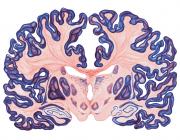Spike timing in the attention network predicts behavioral outcome prior to target selection
Publication Year
2021
Type
Journal Article
Abstract
There has been little evidence linking changes in spiking activity that occur prior to a spatially predictable target (i.e., prior to target selection) to behavioral outcomes, despite such preparatory changes being widely assumed to enhance the sensitivity of sensory processing. We simultaneously recorded from frontal and parietal nodes of the attention network while macaques performed a spatial cueing task. When anticipating a spatially predictable target, different patterns of coupling between spike timing and the oscillatory phase in local field potentials—but not changes in spike rate—were predictive of different behavioral outcomes. These behaviorally relevant differences in local and between-region synchronization occurred among specific cell types that were defined based on their sensory and motor properties, providing insight into the mechanisms underlying enhanced sensory processing prior to target selection. We propose that these changes in neural synchronization reflect differential anticipatory engagement of the network nodes and functional units that shape attention-related sampling.
Journal
Neuron
Volume
109
Issue
1

